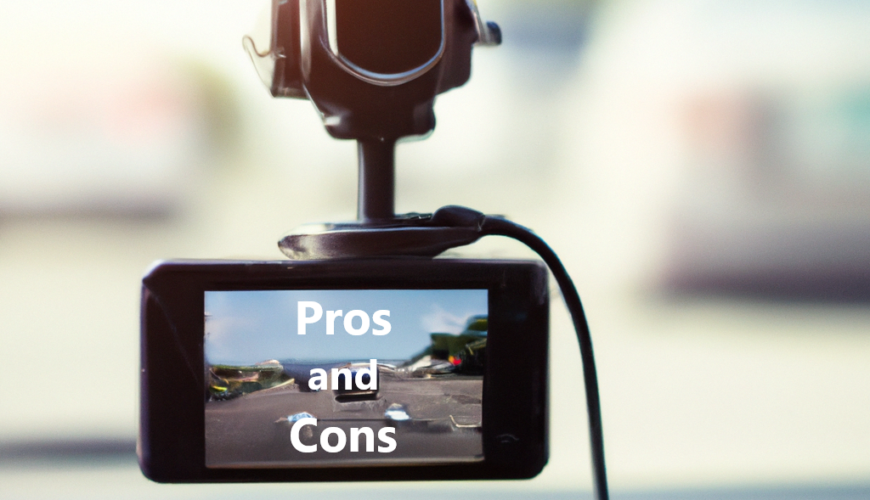
Pros And Cons of using a Dashcam
A dashcam, which is often referred to as a dashboard camera, is a tiny video camera that is put on a car’s dashboard or windscreen. While the car is in motion, it is intended to continually capture the view through the front windscreen. Dashcams can be helpful for a number of things, such as recording instances of careless or risky driving, collecting footage of strange or noteworthy events while travelling, and providing proof in the event of a car accident. We will examine the advantages and disadvantages of utilising a dashcam in this post, as well as the development of this technology.
Pros of using a dashcam:
- Evidence in the event of a car accident: Having a dashcam has several advantages, one of which is the ability to offer evidence in the event of a car accident. The video from your dashcam can be utilised to identify the at-fault party in a collision and assist you in filing a claim with your insurance provider.
- Use a dashcam to record odd or memorable events: Dashcams can be used to record footage of odd or noteworthy incidents you come across while travelling. You might capture a stunning sunset, a meteor shower, or a double rainbow, for instance.
- Record instances of risky or reckless driving: Dashcams can also be used to document risky or reckless driving. You can use the video from your dashcam as proof to report an incident to the police if you see someone driving recklessly or acting in a risky way.
- Deterrent to reckless driving: Drivers may be less likely to engage in risky behavior if they are aware that their actions are being filmed if a dashcam is present. This may serve as a deterrent to reckless driving.
Cons of using a dashcam:
- Cost: The price of a dashcam is one possible drawback. The cost of a dashcam can vary; some high-end ones might be several hundred dollars.
- Privacy concerns: Some people might be concerned about how utilising a dashcam will affect their privacy. While it is typically acceptable to shoot video in public areas, you should be aware of any regional rules that might be relevant. When utilising a dashcam, you should also be considerate of other people’s privacy and refrain from recording them without their permission.
- Distraction: Utilizing a dashcam while driving might be distracting, especially if you are continually reviewing the film or changing the camera’s settings. It’s crucial to maintain constant attention on the road and stay away from any distractions that can raise the likelihood of an accident.
History of dashcams:
The first dashcams were created in the 1970s and were used to record traffic events by the Russian police. Dashcams gained popularity elsewhere during the ensuing decades, particularly in Asia and Europe. The use of dashcams has increased recently in the United States as well. Dashcam production and purchasing have been simpler and more economical as a result of the expansion of high-quality camera and video recording technologies. Dashcams come in a variety of styles now, from basic ones that merely capture video to more sophisticated ones that have capabilities like GPS tracking, motion detection, and event detection.

The ability to employ a dashcam for personal safety is yet another benefit. In some situations, dashcam video can be used as proof to defend you against false accusations or altercations. For instance, if someone accuses you of driving recklessly, the video from your dashcam can be utilised to prove otherwise. Similar to this, if you get into an altercation or incident involving road rage, the video from your dashcam can be used as proof to back up your version of what happened. Dashcams can be utilised as a training tool for novice or new drivers, which is another potential benefit. New drivers can improve their driving skills by seeing film of their actions while behind the wheel. On the other side, potential privacy issues are one of the main drawbacks of utilising a dashcam. Despite the fact that it is typically acceptable to capture video in public areas, you should always be aware of any regional laws or rules that might be relevant. When utilising a dashcam, you should also be considerate of other people’s privacy and refrain from recording them without their permission. Dashcams’ propensity to cause distractions while driving is another possible drawback. Driving while reviewing the video or fiddling with the camera settings can cause you to lose focus and increase your chance of an accident. It’s crucial to set up the dashcam before leaving on the trip in order to prevent this and to refrain from interfering. The administration and storage of the footage is an additional factor to take into account. Dashcam footage is often stored on a memory card, which, depending on the recording resolution, frames per second, and duration of the recording, can soon become full. To avoid running out of memory on the memory card, it’s critical to be aware of the dashcam’s storage capacity and to routinely transfer the video to a computer or external hard drive. If you have a lot of footage to sort through, managing it might also be a pain. Due to the technology’s exorbitant cost in the early dashcam models, the police and business fleets were the main users of these devices. Dashcam usage among private individuals has increased, nevertheless, as technology has evolved and grown more accessible. In recent years, dashcams have grown in popularity in nations with heavy traffic and a high rate of automobile accidents, such Russia and China.
In conclusion, a dashcam can be a practical instrument for recording images of the road ahead, offering proof in the event of an auto accident, and for personal safety. However, there are also possible drawbacks to take into account, such as privacy issues and the possibility of driving while distracted. Before employing a dashcam, it’s crucial to thoroughly assess the advantages and disadvantages and be informed of any legal or regulatory requirements.












